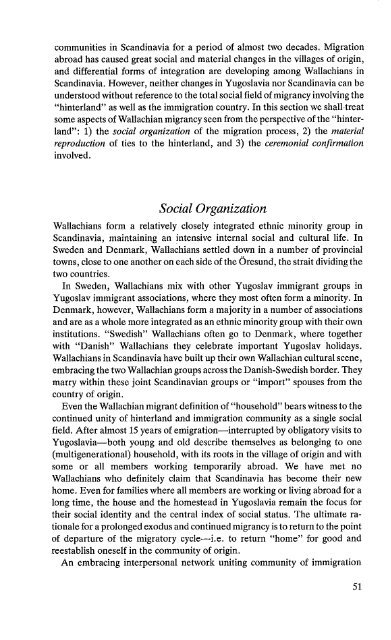Will they still be dancing? (1982)
Etnographic study of Romanians from East Serbia in Sweden in 1980s
Etnographic study of Romanians from East Serbia in Sweden in 1980s
You also want an ePaper? Increase the reach of your titles
YUMPU automatically turns print PDFs into web optimized ePapers that Google loves.
communities in Scandinavia for a period of almost two decades. Migration<br />
abroad has caused great social and material changes in the villages of origin,<br />
and differential forms of integration are developing among Wallachians in<br />
Scandinavia. However, neither changes in Yugoslavia nor Scandinavia can <strong>be</strong><br />
understood without reference to the total social field ofmigrancy involving the<br />
"hinterland" as well as the immigration country. In this section we shalltreat<br />
some aspects ofWallachian migrancy seen from the perspective of the "hinterland":<br />
1) the social organization of the migration process, 2) the material<br />
reproduction of ties to the hinterland, and 3) the ceremonial confirmation<br />
involved.<br />
Social Organization<br />
Wallachians form a relatively closely integrated ethnic minority group in<br />
Scandinavia, maintaining an intensive internal social and cultural life. In<br />
Sweden and Denmark, Wallachians settled down in a num<strong>be</strong>r of provincial<br />
towns, close to one another on each side of the 6resund, the strait dividing the<br />
two countries.<br />
In Sweden, Wallachians mix with other Yugoslav immigrant groups in<br />
Yugoslav immigrant associations, where <strong>they</strong> most often form a minority. In<br />
Denmark, however, Wallachians form a majority in a num<strong>be</strong>r of associations<br />
and are as a whole more integrated as an ethnic minority group with their own<br />
institutions. "Swedish" Wallachians often go to Denmark, where together<br />
with "Danish" Wallachians <strong>they</strong> celebrate important Yugoslav holidays.<br />
Wallachians in Scandinavia have built up their own Wallachian cultural scene,<br />
embracing the two Wallachian groups across the Danish-Swedish border. They<br />
marry within these joint Scandinavian groups or "import" spouses from the<br />
country of origin.<br />
Even the Wallachian migrant definition of "household" <strong>be</strong>ars witness to the<br />
continued unity of hinterland and immigration community as a single social<br />
field. After almost 15 years of emigration-interrupted by obligatory visits to<br />
Yugoslavia-both young and old descri<strong>be</strong> themselves as <strong>be</strong>longing to one<br />
(multigenerational) household, with its roots in the village of origin and with<br />
some or all mem<strong>be</strong>rs working temporarily abroad. We have met no<br />
Wallachians who definitely claim that Scandinavia has <strong>be</strong>come their new<br />
home. Even for families where all mem<strong>be</strong>rs are working or living abroad for a<br />
long time, the house and the homestead in Yugoslavia remain the focus for<br />
their social identity and the central index of social status. The ultimate rationale<br />
for a prolonged exodus and continued migrancy is to return to the point<br />
of departure of the migratory cycle-I.e. to return "home" for good and<br />
reestablish oneself in the community of origin.<br />
An embracing interpersonal network uniting community of immigration<br />
51
















